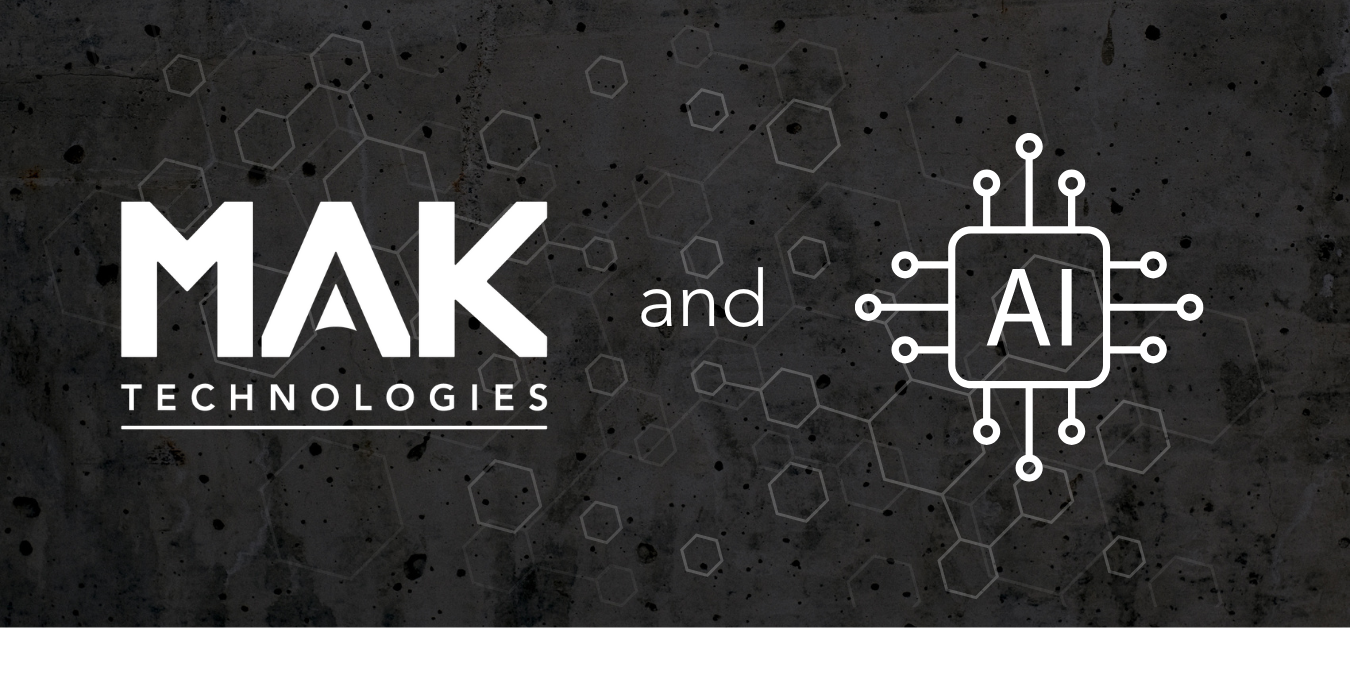
MAK's Approach to AI
by Len Granowetter, CTO
As the AI revolution has heated up, I’ve often been asked: “How is MAK leveraging this new technology? What is MAK’s AI strategy?” I’d like to share how I typically answer this question:
Our AI strategy has three prongs:
- Leverage AI tools within our own software DevOps process to accelerate our development and bring capabilities to our customers faster.
- Make VR-Forces the ideal synthetic environment platform in which our customers can experiment and prototype their own innovative AI solutions.
- Apply AI to make VR-Forces smarter and easier to use – including automated scenario authoring, COA generation, more intelligent CGF entities, and natural-language interfaces.
Below, I’ll describe what we’re doing in each of these three areas:
AI Within MAK’s DevOps Process:
Like many companies, we’ve been actively experimenting with both AI-assisted coding and full-on “vibe coding” – a technique where developers work with AI through natural-language prompts to generate and iteratively modify code until it matches the desired functionality. Our developers all now have access to GitHub Copilot within Microsoft Visual Studio and VS Code, and some have already used it to great success – developing utilities and capabilities much more quickly than through traditional software authoring. For example, our VP of Products, Jim Kogler, rapidly built an HLA FOM Editor almost entirely though AI-generated Python code, which we have already been using for our work for NATO on the NETN FOM.
We’ve learned that as with any powerful tool, AI’s value and usefulness depends greatly on the skill and expertise of the people who wield it. So we’ve been aggressively developing our skills in prompt engineering; comparing ChatGPT, Claude, Gemini and other LLM tools to learn which types of tasks each excels at; developing workflows that avoid some of the well-known pitfalls of AI-based development; keeping security at the forefront of our minds; and exchanging knowledge among our development team at weekly technical education meetings. MAK’s newfound expertise in harnessing the power of AI-driven development will allow our COTS Products team to stay ahead of customer demands, and our Simulation Solutions team to assist customers in their projects even more cost effectively.
VR-Forces as a Platform for AI Innovation
MAK’s goal has always been to provide an open and flexible synthetic environment platform on which our customers, partners and other third parties could add their own unique innovations and craft custom solutions. This philosophy has served us very well in the age of AI!
Countless modeling and simulation companies are making strategic investments in their own AI experiments and projects, and they all need a robust and flexible simulation infrastructure in which to test, demonstrate, exercise, and deploy their models. VR-Forces’ modular design, documented C++ API, Lua scripting capability, remote control interface, and open structured-text configuration files make it an ideal platform for AI development – offering a wide variety of ways to integrate. Some examples of companies we’ve supported in integrating AI-based plug-ins, add-ons, and complementary tools with the MAK ONE / VR-Forces platform include:
- RTDynamics has built an intelligent AI-based agent that can fly dogfighting aircraft within the MAK ONE environment and is using LLMs to generate Lua behavior scripts for VR-Forces.
- ST Engineering Training and Simulation has built an LLM-based Rapid Scenario Generator capability for VR-Forces, and uses AI in their Mission Analytics and Review System (MARS) to interpret collected simulation data and return responses to users’ queries.
- Boston Fusion integrated their Deep Reinforcement Learning engine with VR-Forces for a US Army project focused on AI-based Course of Action generation and analysis.
- Cervus integrated VR-Forces with LLMs to extract and summarize doctrine and research documents and perform automated Course of Action analysis.
- ScenarioAI has integrated LLMs and other AI tools with VR-Forces to generate Orders of Battle, Scenarios, and Simulation Model Sets from public sources for NATO Wargaming.
You can read more about these projects here.
MAK’s Use of AI to Make VR-Forces Smarter and Easier to Use
Beyond helping our customers and partners build their AI extensions to VR-Forces, our own Simulation Solutions Team has been prototyping and developing several AI-based modules that can bring significant value to our customers on top of the core MAK ONE products.
Our efforts date back almost three years to when we first incorporated AI technology into our “MAK FIRES” Call for Fire trainer to replace a human instructor with an intelligent virtual agent. Forward Observer trainees use VR-Engage’s DIS/HLA voice/radio capability to speak naturally to an AI-based simulated Fire Direction Center, which interprets the trainee’s speech, synthesizes appropriate voice responses, and automatically directs VR-Forces to fire simulated artillery and other weapons in response to the trainee’s commands.
We accelerated our use of AI when we developed “NICO” Intelligent Avatars in 2023-2024 to replace live role players with virtual agents in the US Marine Corps’ Immersive Training Environment. After that project was delivered, we decoupled NICO’s AI-based “brain” from the project’s visual elements so that we could apply it to many other use cases – still calling it “NICO AI” to reflect the technology’s roots driving NICO Avatars. Now incorporating the latest LLM technologies, we’ve used our NICO AI capability to implement:
- Voice-driven intelligent virtual crewmates to interact with human players using VR-Engage
- A module for auto-generating VR-Forces scenarios and plans from text-based OPORDs
- The ability to intelligently break down unit-level commands into VR-Forces entity tasks
While we do not have any immediate plans to incorporate NICO AI directly into the MAK ONE products (the technology is still evolving too rapidly for that), our Simulation Solutions team can bring these assets to bear on your custom projects today! If you have a need for such technology or are interested in partnering with MAK to accelerate our R&D work on AI-driven intelligent CGFs, we’d love to talk with you!

